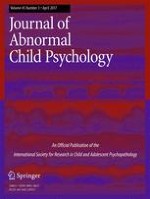15-07-2016
Exploration of the Factor Structure of ADHD in Adolescence through Self, Parent, and Teacher Reports of Symptomatology
Gepubliceerd in: Research on Child and Adolescent Psychopathology | Uitgave 3/2017
Log in om toegang te krijgenAbstract
Factor analytic studies of attention-deficit/hyperactivity disorder (ADHD) in children and adults have shown that second-order and bifactor models better represent ADHD symptoms than two- or three-factor models, yet there is far less evidence for a bestfitting model of ADHD in adolescence. Thus, the current study examined the factor structure of ADHD in adolescence and further evaluated the external validity of the best fitting model. Participants were 588 adolescents (22 % female; 366 with a childhood ADHD diagnosis; mean age 15.9 years) from the 8-year assessment of the Multimodal Treatment Study of Children with ADHD (MTA). ADHD symptoms were assessed via adolescent self-report, parent report, and teacher report on the SNAP-IV scale. Potential factor structures for the 18 symptoms of ADHD were tested for each informant, which included traditional one-factor, two-factor, and three-factor models of ADHD, as well as second-order factor (specific factors loading onto general factor) and bifactor (items loading onto both specific and general factors) models. Unique associations between external criteria and the identified factors of each informant’s best fitting model were examined. Although several of the proposed models exhibited good fit, the second-order two-factor model best accounted for ADHD in adolescence according to self-report and parent report, and the second-order three-factor model was optimal according to teacher report. Several key measurement issues emerged for the hierarchical bifactor models, such as numerous Heywood cases and out-of-bound parameter estimates, which rendered them unfit as optimal representations of ADHD in adolescence. These findings and the implications of the best fitting model of ADHD in adolescence suggest that a possible reorganization of this disorder may eventually aid clinicians in the accurate diagnosis of ADHD in adolescents.
